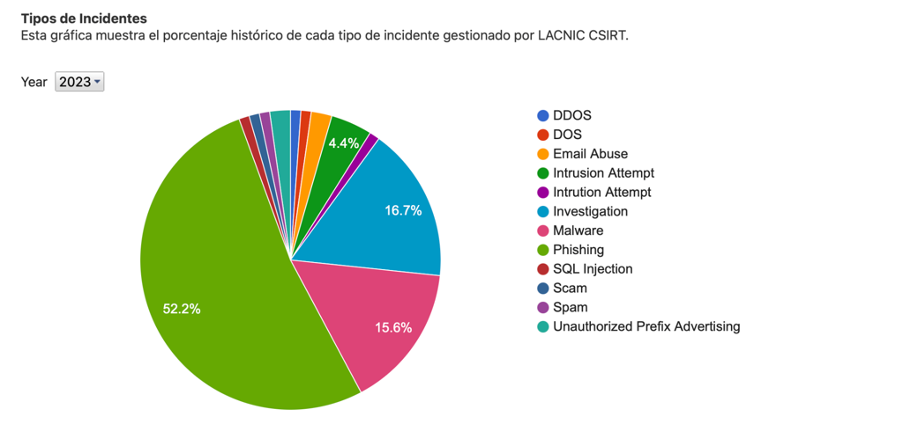A Year of Increasingly Sophisticated Security Incidents
04/01/2024

By Graciela Martínez, Head of LACNIC CSIRT, and Guillermo Pereyra, Security Analyst at LACNIC
Last year, security incidents in the region have become increasingly advanced and sophisticated, exploiting new methods to deceive individuals and organizations. These conclusions can be derived from the reports generated by LACNIC CSIRT to understand the state of the Internet resources under our administration.
Phishing and spam for malicious purposes, whether originating from or directed towards resources in the region, continue to be the most frequently reported incidents at our CSIRT.
Data collected from collaborating organizations and our own sources indicate a clear evolution of statistics towards these phishing and spam episodes.

Why are attacks becoming more sophisticated? Attackers now gather intelligence and don’t always go directly for the organization. Their goal is often to exploit the supply chain and they attempt to attack an organization from the periphery, through a supplier, or a client.
For instance, when an attacker successfully breaches a client (who typically has fewer defenses), they obtain valid credentials and use them to access your email accounts. Once the attacker has gained access to a legitimate account, they attempt to deceive the staff of the organization that is the ultimate target of the attack. In this regard, they have advanced toward a more sophisticated form of identity theft, as the malicious link is part of a legitimate email, which makes it more difficult to detect.
Our primary recommendation is to reinforce the policies related to safeguarding information security, considering the risks to which it is exposed, and actively working on raising awareness among employees.
Malware. Reports from third parties regarding malware in their networks have also increased significantly in the region. Botnets are employed as malicious agents to attack the victim.
Last year has also seen an increase in ransomware attacks on smaller organizations. This trend is closely associated with the goal of cybercrime, namely, economic gain.
Cybercriminals now operate within organized structures akin to traditional criminal structures. As cybercrime evolved, it transitioned from attacking individuals to targeting organizations and, more recently, entire networks.
A revealing fact is that, according to international statistics, ransom collection grew from an average of $8,100 to an average of $2.5 million in just a few years. This confirms cybercriminals’ financial motivations for these attacks.
Spear phishing. Advanced cybercriminal techniques have led to targeted phishing attacks, commonly known as spear phishing. These are personalized cyberattacks directed at specific individuals or companies. They are typically implemented via spear phishing emails that appear legitimate to the recipient and persuade them to share sensitive data with the attacker.
These attacks are much more successful than standard phishing attacks. By leveraging the information they obtain, attackers can use social engineering techniques to design custom attacks to deceive the target into believing they are receiving legitimate requests and emails. As a result, even the most ambitious targets within an organization, such as senior executives, may open email messages that appear harmless to them and fall victim to these attacks. This type of inadvertent errors allow cybercriminals to steal the data they need to launch an attack on their target network.
The Statistics on our website detail the mechanisms most commonly used by cybercriminals, as well as servers by RIR and by country.
LACNIC CSIRT publishes a Security Incident Management Plan to help organizations prepare to handle security incidents. The purpose of this guide is for readers to understand the basic definitions needed for each stage from a management point of view. A proactive approach involves understanding the importance of being prepared and taking the necessary steps to do it.